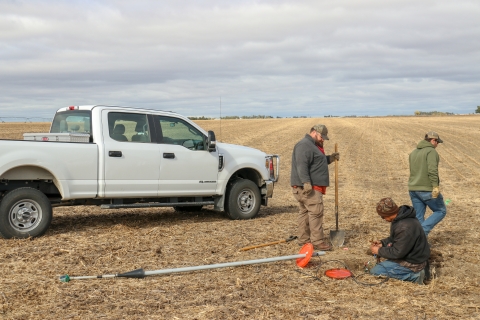The planting of cover crops is utilized for many soil health benefits, and it is widely accepted that cover crops reduce erosion by anchoring the soil. One thing not often discussed is how cover crops might affect potential groundwater recharge and if there is the possibility of negative impacts to water quantity and to the producer’s water budget. To explore these possibilities further, the Lower Loup NRD and the Central Platte NRD partnered with EA Engineering, Science, and Technology, Inc, PBC to study the impacts of growing cover crops in southern Buffalo County where the aquifer is limited, and the water levels have declined in recent years. The study area is between the Wood River and South Loup River.
Within this area, three irrigated row crop fields were selected and monitored for a period of three growing seasons.
The project aimed to gain a better understanding of the general influence of cover crops on soil moisture and potential groundwater recharge. Soil samples to a depth of 15 foot were also collected to study the movement of nitrate vertically through and below the root zone.
The study design was to select fields where during winter months, the grower would plant half the field with a cover crop and maintain the other half with no cover crop. This would allow for a comparison between Cover Crop and No Cover Crop in the same field.
Soil moisture probes were installed at depths of 18, 72, and 84 inches to monitor the movement of water through the root zone and into the unsaturated zone, also known as the vadose zone. Water not utilized by the growing crop would be accounted for by the deeper sensors and would be considered groundwater recharge. A cellular gateway allowed for the collection of data throughout the entire calendar year. Equipment was only removed for the planting and harvesting of crops.
At the completion of the project, the annual potential groundwater recharge was averaged together across the three fields for the entire study duration. Results showed no statistical difference between Cover Crop and No Cover Crop areas.
Since individual seasons or years can vary greatly, longer duration data may be needed to determine if a consistent trend is observed and allow for developing long-term conclusions.
For additional information, please contact Jason Moudry at the Lower Loup NRD at (308) 728-3221.
